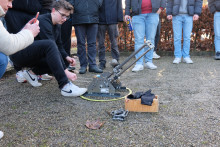What happens if you place the axis of a wind turbine vertically instead of horizontally? And what if the blades actively align themselves with the airflow? It was mainly the implementation of that second idea that earned Vernhout a ten for his thesis.
‘Just to be clear, a wind turbine is not the same as a windmill,’ Vernhout explains. ‘A turbine has vanes or blades and converts wind into rotation, but it is only called a mill if the rotation is used for something mechanical, such as grinding paper, flour, or sawing wood.’
Energy transition
Vernhout is driven by a desire to contribute to the climate challenge and the transition to renewable energy. For that reason, he entered the Energy and Flow research direction within Mechanical Engineering, which focuses on energy-producing systems. He immersed himself in an aerodynamic challenge involving wind turbines.
The problem: fixed blades and a single wind direction
‘The idea of a horizontal turbine that rotates around a vertical axis is not new,’ Vernhout says. ‘It simply wasn’t used because, compared to an upright turbine, the net energy gain is too low. A blade that is pushed around the axis by the wind ends up facing that same wind again after half a rotation, which slows the system down. Even modern versions of such turbines face a similar issue and only reach around 35 percent power efficiency, compared to roughly 50 percent for upright turbines.’
Yet those upright turbines are not popular either, since they are expensive to build, especially offshore. Meanwhile, by 2050, the EU wants most of Europe’s electricity to come from renewable sources.
The solution: blade angle adjustment
But what if the blades in the turbine rotate a few degrees halfway through the cycle, allowing them to cut through the wind like an aircraft wing or a sail? Or better still, what if the blades continuously orient themselves into the wind? That is the principle Vernhout proposes in his Master’s thesis. He even developed an app to operate the turbine and monitor the wind tunnel data.
Building the prototype was not straightforward. ‘The first version I cobbled together myself could not withstand the wind tunnel. Based on the physics and simulations I had already done, I could have concluded that the idea did not work and that further research was needed. But I wanted to build something that actually solved a problem, so I kept improving it until it did work. I think that ultimately earned me the ten.’
The benefits: more power, less disturbance
The first wind tunnel tests immediately showed results. The turbine performs better than current wind turbines. ‘If you place them together in a wind farm, the turbines can stand closer together and the overall energy yield increases by three to five times,’ he says. Another advantage is that Vernhout’s turbine does not need to be hundreds of metres tall. A height of just a few metres is enough, which means almost no noise and hardly any shadow flicker.
He also solved the problem of the generator’s position. ‘Traditional wind turbines are top heavy, which is far from ideal, especially for floating offshore turbines.’ In his design, the generator sits at the bottom, making maintenance much easier.
‘Sustainability is very important to me. Traditional turbines are a major ecological challenge because you cannot recycle them. Thanks to the design, mine can be made from aluminium or even wood,’ Vernhout explains. He already envisions smaller versions being placed on business parks to reduce pressure on local grids, or at charging stations for electric vehicles.
Unilever Research Prize
All this earned him the Unilever Research Prize. In addition to broad recognition, he receives a 2,500 euro cash award. Unilever’s criteria focus on sustainability and environmental impact. Innovations must contribute to the Sustainable Development Goals of the World Health Organisation. ‘Mine fits with Goal 7, affordable and clean energy.’
Horst Tower
Although the work turned out to be far more extensive than he expected, Vernhout wants to continue developing the concept at UT. The Engineering Fluid Dynamics group led by Kees Venner supports him. At the same time, he plans to start a company so that he can already bring the idea to market on a small scale. His dream? ‘It would be amazing to place one of them on top of the Horst Tower.’





